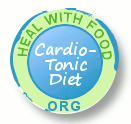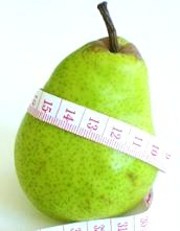Cardiotonic Diet & the Best Vitamins for Cardiovascular Health

This article presents 9 powerful dietary habits that can have a strong cardiotonic effect (heart strengthening and protecting effect) on your body. These cardiotonic diet tips should help you determine the best vitamins and foods for your heart; however, you should keep in mind that the information below and elsewhere on this website is not intended or implied to be a substitute for professional medical or health advice. Always seek the advice of a professional health care provider.
#1: Consume Foods That Contain Vitamin K
Vitamin K is best known for its role in normal blood coagulation, but recent research suggests it may also be one of the best vitamins for both cardiovascular health and bone health. Bones require calcium in order to stay strong and healthy while arteries may become calcified by excess calcium. Vitamin K helps incorporate calcium into bone while preventing its deposit within blood vessels. Green leafy vegetables, such as spinach, Brussels sprouts, broccoli, Swiss chard, asparagus, green beans, kale and mustard greens, provide a good source of this important cardioprotective vitamin. In addition, vitamin K can be synthesized by certain 'friendly bacteria' that live in the large intestine. Live culture foods, such as yogurt, kefir, and sauerkraut, can help deposit such friendly bacteria in the intestines. A diet rich in live culture foods may be particularly beneficial for people who have an imbalance of intestinal flora due to antibiotics or a disease affecting the intestines.
Caution: people who take blood thinners should not take vitamin K supplements without consulting their doctor.
#2: Include Foods Rich in Coenzyme Q10 in Your Cardiotonic Diet
There is some evidence that a regular intake of coenzyme Q10 (also known as ubiquinone or CoQ10) may help improve cardiovascular health in the long term, particularly in individuals with an increased risk of heart failure. CoQ10 is a vitamin-like substance that is found in all human cells and that the human body is able to make, to some extent, on its own. However, the body's ability to produce this important substance declines dramatically as we age.
Luckily, CoQ10 is also found in a number of foods, the richest dietary sources being red meat — particularly organ meats such as liver and heart — and fresh sardines and mackerel. It is also found in spinach, broccoli, peanuts, whole grain, and wheat germ. Processing and cooking decrease the CoQ10 content of foods.
The cardiotonic properties of coenzyme Q10 are thought to relate to its role as a carrier in the body: CoQ10 transports stored energy to other areas of the body, including the heart muscle, where the energy can then be used. CoQ10 may also inhibit blood clot formation. In addition, CoQ10 has strong antioxidant properties and is able to boost the antioxidant effect of vitamins C and E.
#3: Choose Low-GI Carbs
Carbs that have a high glycemic index (GI) rating are quickly broken down by the body and cause blood glucose levels to spike. This in turn triggers the pancreas to rapidly release large amounts of insulin. Insulin is necessary for the body to be able to use glucose for energy, but high amounts of insulin can be harmful to the heart in obese or overweight people.
The Nurses' Health Study — a large cohort study investigating factors influencing women's health — found that the risk of heart disease was twice as high among overweight women who ate the most high glycemic foods, compared to those who ate the least of these foods. This study found no link between heart disease and high glycemic index foods among lean women. This does not mean, however, that you should keep eating high glycemic foods if you are at normal weight: a regular consumption of high glycemic foods can promote weight gain! Most non-starchy vegetables, legumes and fruit have a low GI rating while most refined carbohydrate-rich foods are rated high on the glycemic index.
#4: Ensure a Sufficient Fiber Intake
Dietary fiber is the part of plant foods that the enzymes in your body cannot digest. It is therefore not absorbed into the bloodstream and cannot be used for energy. Dietary fiber can be classified into two main categories: soluble and insoluble fiber. Soluble fiber forms a gel when mixed with water while insoluble fiber, which does not dissolve in water, passes the intestines largely intact. Soluble fiber has been shown to protect against heart attacks and heart disease, which makes it an important component of any cardiotonic diet. The cardiotonic effects of soluble fiber are linked to its ability to lower blood cholesterol levels by binding to harmful cholesterol (LDL) in the small intestine and carrying it out of the body. Excellent sources of soluble fiber include oats, flaxseed, peas, beans, apples, carrots, barley, berries and psyllium.
#5: Ensure a Sufficient Intake of Vitamin D
Vitamin D is well known for its role in maintaining strong bones, but in recent years vitamin D has also been heralded for its potentially cardiotonic effects. The idea that vitamin D might protect against heart disease arose when researchers found that the farther north you live, the higher your risk of suffering a heart attack. The most important source of vitamin D is sunlight — which is in short supply in northern latitudes during winter months.
Recent studies have provided more evidence supporting a possible link between low levels of vitamin D and an increased risk of cardiovascular disease. Vitamin D deficiency has been associated with inflammation, high blood pressure, and diabetes — all of which are known to increase the risk of cardiovascular disease. Further, low levels of vitamin D have been observed in people with atherosclerosis and in heart attack sufferers.
When exposed to sunlight, the body can synthesize its own vitamin D. Keep in mind, though, that overexposure to the sun can cause short-term sunburn as well as long-term damage, including premature skin aging and cell mutation in the skin layers, which may lead to skin cancer. For most people, 5 to 30 minutes per day of sun exposure on the face and arms is enough. It is also possible to get vitamin D through diet. The best sources of vitamin D include liver, egg yolks, fish, and vitamin-D fortified milk products.
#6: Cut Down on Calories, Especially in the Evening
Obesity and excess weight have been associated with numerous cardiovascular diseases and complications, including heart attack, congestive heart failure, sudden cardiac death, angina and chest pain. Also high blood pressure is twice as common in obese adults as in adults who are at a normal weight. If you are overweight, make weight loss your primary goal. (For additional information, check out the nutrition guidelines on how to successfully fight overweight.)

To lose weight, you will have to create a calorie deficit, either by reducing calorie intake from foods so that your body must draw on reserves for energy (such as stored fat) or by increasing physical activity. To lose 1 pound per week, you need to create a deficit of 3,500 calories per week. This can be done by reducing a daily caloric intake by 500 calories (500 calories x 7 days = 3,500 calories). Most health professionals recommend creating a caloric deficit of 3,500 to 7,000 per week for healthy weight loss. An extreme deficit (a deficit of more than 7,000-10,500 calories per week) can compromise bodily functions and even result in fatal heart rhythm abnormalities.
Furthermore, cutting too many calories may also be counterproductive to weight loss efforts, as extremely low calorie diets boost the activity of fat-storing enzymes and decrease the activity of fat-burning enzymes in the body. In addition, cutting too many of calories can accelerate loss of lean muscle mass and decrease the output of the thyroid hormone, which will result in a decrease in the metabolic rate and thus fewer calories will be burned throughout the day.
In addition to restricting the amount of calories consumed, overweight people should pay attention to the timing of the daily caloric intake. It is generally recommended to spread the calories throughout the day by having five to six small meals. This will keep the metabolism humming and reduce cravings for sweets and starches. Breakfast should be the biggest meal of the day as a robust breakfast will help get your metabolism going and you will burn more fat throughout the day.
#7: Favor Omega-3 Fats, Avoid Trans Fats
If you are looking to improve your cardiovascular health through a cardiotonic diet, be sure to consume plenty of omega-3 fats. A large body of evidence suggests that omega-3 fatty acids can protect against CVD. These cardioprotective effects are believed to be linked to omega-3 fatty acids' ability to prevent blood clots and to reduce inflammation in the artery walls. Today, most modern diets in Western countries do not contain enough omega-3 acids. To increase your intake of omega-3s, eat plenty of such foods as flaxseeds, walnuts, soybeans, and cold water fish like salmon, cod, and halibut.
Trans fats, or trans fatty acids, are formed in a chemical process that food manufacturers use to turn liquid oils into solid fats and to increase the shelf life of foods. Consumption of trans fats has been shown to increase low-density lipoprotein cholesterol (LDL or "bad" cholesterol), which increases the risk of coronary heart disease, and to lower high-density lipoprotein (HDL or "good" cholesterol). One study found that women in the US with the highest blood levels of trans fats were three times as likely to develop coronary heart disease as women with the lowest levels. Trans fats are most often found in fried foods, vegetable shortenings, hard margarine, cookies, crackers, chips, and baked goods.
#8: Cut Back on Salt, Push Up Potassium Levels
Sodium (salt) and potassium play a key role in maintaining blood pressure in the body. In order for the body to maintain an optimal balance, a relatively high concentration of potassium and a low concentration of sodium are required. However, most Western diets contain much more sodium than recommended by any health authority. Indeed, too high an intake of sodium is one of the most common causes of high blood pressure in many countries. To counteract some of the harmful effects of excess sodium, eat a lot of potassium rich foods, such as root vegetables and bananas, which help regulate blood pressure. Of course, you should also avoid excess salt in the first place. If you feel your food is lacking flavor, use spices and herbs instead of large amounts of salt. Be also aware of the "hidden" salt that is present in many packaged and processed foods.
#9: Eat Foods That Contain Chromium
Chromium is a component of the glucose tolerance factor (GTF) which helps maintain normal blood glucose levels by making insulin, a hormone that controls these levels, more efficient. This will fight insulin resistance which is a condition in which the body does not respond to normal levels of insulin and as a result secretes more insulin into the bloodstream in an effort to reduce blood glucose levels. Insulin resistance is often associated with high levels of triglycerides in blood. High levels of triglycerides are believed to have a major role in many heart health problems, including heart attack and stroke.




